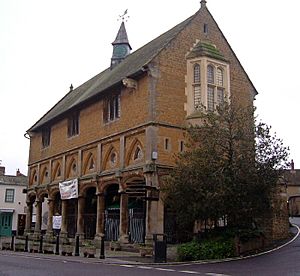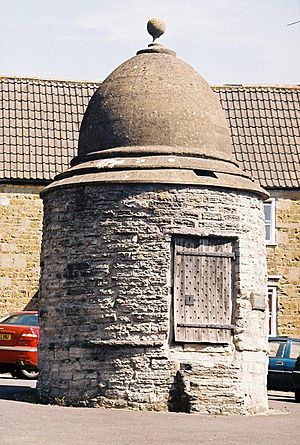Castle Cary facts for kids
Quick facts for kids Castle Cary |
|
|---|---|
 In the foreground, the motte and bailey of the old castle. Behind is All Saints church |
|
| Population | 2,276 (2011) |
| OS grid reference | ST641322 |
| District | |
| Shire county | |
| Region | |
| Country | England |
| Sovereign state | United Kingdom |
| Post town | CASTLE CARY |
| Postcode district | BA7 |
| Dialling code | 01963 |
| Police | Avon and Somerset |
| Fire | Devon and Somerset |
| Ambulance | South Western |
| EU Parliament | South West England |
| UK Parliament |
|
Castle Cary is a small market town and parish in south Somerset, England. It is about 5 kilometres (3 miles) north west of Wincanton and 8 kilometres (5 miles) south of Shepton Mallet. The town sits at the bottom of Lodge Hill, next to the River Cary, which flows into the Parrett.
Contents
History of Castle Cary
The name "Cary" comes from an old Celtic word, caer, which means "rock", "crag", or "castle". So, "Castle Cary" actually means "Castle Castle"! It's a bit of a double name. The town gets part of its name from the River Cary.
The first Cary Castle was built by the Normans after they conquered England in 1066. It was made of wood, following their building traditions. This castle was attacked twice, in 1138 and again in 1152.
Later, around 1250, a second castle was started. This one was built from local stone. By the mid-1400s, people stopped using this castle. Its stones were then used to build other parts of the town. This suggests that the Church of All Saints, Castle Cary might have started being built around the same time and was finished over many years.
Castle Cary Manor and Town Life
The land of Castle Cary, known as Castle Cary Manor, was given to the Lovel family by King Stephen in the 1100s. King Stephen himself attacked the castle in 1138 during his fight for the English throne.
Over time, the manor changed hands many times, often through marriage or when families didn't have male heirs. For example, when the Lovels didn't have a son, it passed to Nicholas de S. Maure. Later, it went to Lord Zouches. When the Zouches supported the wrong king (Richard III) against the Tudors, King Henry VII took their lands and gave the castle to Robert Willoughby.
In 1468, Castle Cary was officially allowed to hold a market by King Edward V. This helped the town grow. Many local businesses started, especially those working with wool. The Greene King George Hotel was built around this time, and the Market House was rebuilt in 1616 using local stone.
By the 16th century, Castle Cary was doing very well. Later, in the 1700s, linen weaving became important. In 1837, John Boyd started making horse-hair fabrics, which his company still makes today using very old looms! The diary of Reverend James Woodforde, who was born nearby in 1740, tells us a lot about life in the area in the 1700s.
In the late 1700s, the Hoare family bought the manor. Henry Hobhouse Esquire also bought Hadspen House nearby. These families invested a lot in Castle Cary, helping it change and grow. New businesses like flax mills, which made twine and sail cloth, were set up. The town's Cricket Club was founded in 1837 and even won an Olympic medal in 1900!
The railway station was built, and the Market House was rebuilt in 1855 because people expected more trade. Today, Castle Cary station is famous as the main stop for people going to the Glastonbury Festival. The town has grown northwards in recent years, but its center still looks much the same.
On June 19, 2004, Castle Cary became a Fairtrade Village, which means it supports fair prices for producers in developing countries.
How Castle Cary is Governed
Castle Cary is part of the Castle Cary electoral division. This division chooses two councillors to represent the area on the Somerset Council, which manages many local services.
The town also has its own Town Council. This council looks after more local matters, like parks and community events.
For national government, Castle Cary is part of the Glastonbury and Somerton area, which elects a Member of Parliament (MP) to the House of Commons in London.
Transport
Castle Cary railway station is an important stop on two main train lines: the Reading to Taunton line and the Heart of Wessex line. The station is about 1.6 kilometres (1 mile) north of the town.
Every summer, thousands of people use this station to travel to the famous Glastonbury Festival. Free buses and coaches take ticket holders from the station to the festival site, which is about 11 kilometres (7 miles) away.
Bus services also connect Castle Cary to nearby towns like Yeovil, Shepton Mallet, Street, and Wincanton.
The town is also on the Monarch's Way, a long walking path that follows the escape route of King Charles II after a battle.
Media
For local news and TV shows, people in Castle Cary can watch BBC West and ITV West Country. These signals come from the Mendip TV transmitter.
Local radio stations include BBC Radio Somerset, Heart West, Greatest Hits Radio South West, and Radio Ninesprings, which is a community radio station for the area. The local newspaper, Western Gazette, is published every Thursday.
Landmarks
One interesting landmark in Castle Cary is a small, round prison from the 1700s called the Roundhouse. It was a temporary prison, or village lock-up, built in 1779. It's made of stone, has a round shape, and a domed roof. It's about 2.1 metres (7 feet) wide and 3 metres (10 feet) high, with two iron grates for air. It has two doors and a small toilet inside. In 1992, the Lord of the Manor gave this unique building to the town council.
The Market House is a beautiful old building, built in 1855. It was designed by Francis Penrose and replaced an older market house from 1616. The new building was made bigger and better because people expected more trade when the railway arrived.
Today, the Market House is home to the Castle Cary and District Museum. Inside, you can see many interesting things. There are local fossils, including ammonites, and a display about an ichthyosaurus found nearby. You can also learn about local industries like rope and hemp making, and see old farming tools. One room is dedicated to Parson James Woodforde, who was born near Castle Cary in 1740. He kept a diary for almost 45 years, which gives us a great look into everyday life in rural England in the 1700s.
Hadspen House is a grand manor house just outside town. The Hobhouse family has owned it since 1785. Its gardens were beautifully restored by the famous garden designer Penelope Hobhouse in the late 1960s.
The Top Mill Building at Higher Flax Mills, built in the 1800s, is also a notable historic building.
Religious Sites
The biggest church in Castle Cary is All Saints'. It was built in 1470 and is known for its tall steeple. The steeple holds six bells that were made in 1760. This church is considered a very important historic building. There is also an old monument in the churchyard from the 1500s.
The town also has a Methodist church, and St Andrew's church is in the next-door parish of Ansford.
Notable Residents
Some famous people have connections to Castle Cary:
- James Woodforde (1740–1803) was a diarist who lived in the town as a curate from 1765 to 1775.
- Douglas Macmillan (1884–1969) was the person who started the Macmillan Cancer Relief charity, which helps people with cancer. A walking trail called the Macmillan Way passes through Castle Cary.
- Jane Wallas Penfold (1820–1884) was an author who wrote a book called Madeira: Flowers, Fruits and Ferns in 1845.
Education
Castle Cary has both a primary school and a secondary school. Castle Cary Community Primary School has been around since 1840. The secondary school, Ansford Academy, was built in 1940. It has had new rooms added over the years for subjects like science, technology, math, and languages. A new Sports Centre, costing £1.7 million, was finished in 2005.
See also
 In Spanish: Castle Cary para niños
In Spanish: Castle Cary para niños




